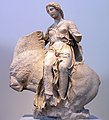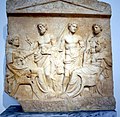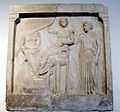User:Zde/Classical sculpture in NAMA
Classical Greek sculpture in the National Archaeological Museum of Athens
Including Hellenistic reminiscences and copies from Roman period
Without small bronzes and small terraccotas, these are separately
Ground floor, Rooms 14 –28
Rooms
[edit]-
Room 15
-
Room 15
-
Room 16
-
Room 17
-
Room 19
-
Room 20
-
Room 21
-
Room 21
-
Room 28
Early Classical sculpture
[edit]Room 14 – 15
-
Poseidon, 480 BC
-
Head of Dionysus, 480-470 BC, early classical archaistic work, Athens
-
Head of Zeus, 480 BC
-
Dog, fragment grave stele, Anafi, 460 BC
-
Grave stele: a man carries a rabbit, 450 BC
-
Fragment of the grave stele, man sitting on the throne, 450-400 BC
-
Ekedamos grave stele with a cock, 440 BC
Classical sculpture in Room 15
[edit]-
Herm of Hermes, copy of the original 5 century BC
-
Minotaur, Roman copy after early Hellenistic work of Myron's group
Self-crowning athlete NAMA 3344
[edit]Reliefː the self-crowning athlete or ephebe, probably the winner of the local games, pentelic marble, circa 460 BC. Finding: near Athena Temple at Cape Sounion.
God of Cape Artemision X15161
[edit]Poseidon or Zeus, bronze, 209 cm, 460 BC, severe style
Apollo Omphalos NAMA 45
[edit]Apollo Omphalos, marble copy of 2 century AD, after bronze from ca 450 BC. He stood on Omphalus at Theatre of Dionysus in Athens. National Archaeological Museum of Athens no. 45.
Young seer NAMA 248
[edit]Statue of a nude youth. Found in the area of the Olympian Zeus Temple. According to one view, the statue renders the Splanchnoptes by the Cypriot sculptor Styppax, a bronze statue of the 425-400 BC. According to Plinius, that statue depicted a young boy ready to spit-roast the entrails for the sacrifice, simultaneously, blowing to light the fire. Eclectic work of the 2nd century AD.
Great Eleusinian relief NAMA 126
[edit]Demeter and Persephone celebrating the Eleusinian Mysteries. On the left Demeter, wearing the peplos and holding a scepter in her left hand, presents Triptolemus with sheafs of wheat, for him to give them to humanity. On the right Persephone, wearing the chiton and a cloak and holding a torch, blesses Triptolemus with her left hand. Votive relief, Pentelic marble, ca. 440–430 BC.
Classical sculpture in Room 20
[edit]-
Aura, 5th century BC
-
Pyrric dancers, 375 BC
-
Roman copy
-
Head of Hermes, Roman copy
Cassel Apollo
[edit]Roman copy of the 2nd century AD, in the type of the Kassel Apollo, of the bronze Apollo Parnopios, an early work by Pheidias, ca 450 BC.
Athena Varvakeion
[edit]Small Roman replica of the Athena Parthenos by Phidias, 477 BC. Found in Athens near the Varvakeion school, hence the name. First half of the 3rd c. AD.
Pnyx Athena NAMA 3718
[edit]Bust in pentelic marble found in Athens on the Pnyx hill, that used to top a colossal statue dating from the Roman era (2nd century AD). This is a copy after an original statue by Phidias or by a pupil of his, dating after 430 BC.
Sculpture in Room 21
[edit]“Room of the Diadoumenos”
-
Aphrodite pudica, Roman copy, NAMA 3524
-
Atalante Hermes, Roman copy of a statue type of the 4th century BC, NAMA 240
Diadoumenos
[edit]Images of the copy of the Diadumenos in the National Archaeological Museum in Athens. Island marble, copy of 100 BC after a Greek original of ca. 425-400 BC by Polycletus. Found in the House of the Diadumenos at Delos. NAMA 1826.
Athlete from Eleusis
[edit]Roman copy or reworking from Polykleitos original 440 BC, possibly a portrait of athlete Kyniskos. NAMA 254.
Hermes from Aigion NAMA 241
[edit]Sculpture in Room 22
[edit]“Room of Epidauros” Sculpture from Asklepios (Asclepius) Temple and Artemis Temple at Epidauros
-
Aura, from Asklepios temple, 380 BC
-
Nike NAMA 155, from Asklepios temple, 380 BC
-
Hygieia NAMA 299; 380-370 BC
-
Nike NAMA 159, from Artemis temple, 330-300 BC
-
Asklepios NAMA 263, Roman copy
Sculpture in Room 28
[edit]“Room of the Youth of Antikythera”
-
Armed Aphrodite, NAMA 262, Roman copy
-
Hygieia by Skopas, NAMA 3602
Youth of Antikythera
[edit]Antikythera Ephebe. Bronze Sculpture, thought to be either Paris or Perseus (Paris is more probable), circa 340-330 BC, National Archaeological Museum 13396. Comes from the Antikythera shipwreck. Attributed to Euphranor.
Marathon Boy
[edit]Probably athlete, work of the Praxitelian chool, 340-330 BC, NAMA X 15118.
Grave Monuments of the 5th century BC
[edit]Rooms 15 – 19
-
Anthemion (Palmeta) from the grave stele, 440 BC
-
430-420 BC
-
Menesagora and the child Nikocharos, circa 420 BC
-
Aristilla and Rhodilla, 420 BC
-
Hedyste, 400 BC
-
Amphiglyphon, 410 BC
-
Dionysos, 400 BC
-
Hegeso, 410 BC
Marlbe lekythoi
[edit]Classical marble lekythoi, Room 16
-
Funerary lekythos of a priest, 350 BC
Funerary lekythos for Myrrhine
[edit]Attic funerary lekythos for Myrrhine, represented while she is taken by hand by Hermes psychopompos to be escorted to Hades. From Athens, 420–410 BC.
Votive relief from Mantineia NAMA 226
[edit]Found in Mantineia, Arkadia, 420-410 BC. It represents a woman holding intestines in her left hand. The trunk of palm-tree is shown at bottom left. The relief probably depicts Diotima, the famous soothsayer and priestess, known of Plato’s Symposion.
Other votive reliefs
[edit]Room 19
-
Apollo sitting on the Delphic tripod, Artemis and Leto, Ahens, 5th century BC
-
Funerary banquet, 5th century BC
Grave Monuments of the 4th century BC
[edit]Rooms 22 – 28
-
Funerary Siren, 370 BC, NAMA 774
-
350 BC
-
Grave relif, 380 BC, NAMA 3716
-
A feline, 350-325 BC, NAMA 4763
-
Mithridates funerary relief, horse and Young Ethiopean slave, late(?) 4th century BC or Roman copy
-
Bryaxis Amazonomachy, 350 BC











































































































































